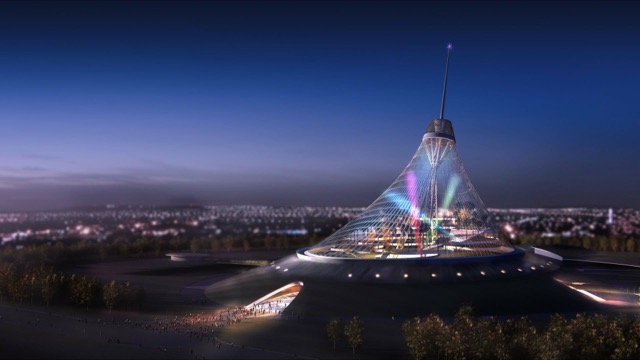Norman Foster’s Khan Shatyr Entertainment Center in Astana, Kazakhstan
The movement to declaring a climate emergency is growing. The latest declaration is from 17 Royal Institute of British Architects Stirling Prize-winning architects who last month launched an “Architects Declare” manifesto, following the UK government’s declaration – the first in the world – of a climate emergency. But is what they’re designing sustainable? Check out International Passive House Day to see something that is sustainable.
It is an unprecedented rallying cry for the profession to take action on the twin crises of climate change and biodiversity loss.
The manifesto states:
“The research and technology exist for us to begin that transformation now, but what has been lacking is collective will. Recognising this, we are committing to strengthen our working practices to create architecture and urbanism that has a more positive impact on the world around us.”
They are calling on all architects in the UK to sign up to the 11 pledges. So far 465 have signed up.
The manifesto highlights biodiversity loss as well as carbon dioxide emissions because the twin and connected crises are a function of masterplanning and site planning as much as building design.
Among the pledges are to upgrade existing buildings for extended use rather than build new ones, to use life cycle costing, whole life carbon modelling and post occupancy evaluation to reduce both embodied and operational resource use, and to use low embodied carbon materials as much as possible.
Hypocrisy?
Some of the architects signing up have come up for criticism. Hattie Hartman writing in the Architects Journal said:
The 17 founding signatories to Architects Declare must now walk the talk. An obvious first step would be for them to share their sustainable design best practice, both current and planned. These should include measurable targets, reported regularly. A handful of practices already do this but they are in the minority.
Some of their work hardly meets the expected standard, such as Zaha Hadid’s Port Authority building in Antwerp, Belgium.
When architects design for status and take high-profile commissions from high profile clients in order to win prestige, this often results in compromising their sustainability principles and sends out a completely wrong message to a large audience.
Norman Foster – designer of towers in China and India, and Apple’s new headquarters – is on record as saying: “I have no power as an architect, none whatsoever. I can’t even go on to a building site and tell people what to do. Advocacy is the only power an architect ever has.”
This is entirely disingenuous. An architect has the power to choose to do a project. Many practices specialise only in sustainability. They educate their clients. They can specify low or negative carbon materials. They can reduce supply chains. They can design for long-term low energy use.
The negative role of “starchitects”
As a “starchitect” Norman Foster knows that host cities – such as Astana – commission megastructures like his to flatter themselves.
One of Foster’s two buildings for this Kazakstan vanity project for its oil-rich dictator, the Khan Shatyr Entertainment Center, includes an artificial beach with sand imported from the Maldives. How sustainable is that?
One of the other big signatories, HOK, has just started work on the expansion of terminal five of Chicago’s international airport.
It’s easy to criticise architects, but if the Architects Declare manifesto is not to be seen as mere greenwash, then from now on the signatories need to practice what they preach.
International Passivhaus open day shows what sustainability can really look like
If you want to see real sustainability in practice then from June 28-30 Passivhaus homes around the world are opening their doors to visitors.
An interactive map is on the above link to find the one nearest you – although if you live in Asia, Africa or South America you might find your journey rather far. At the time of writing there are three registered in Australia and 11 in New Zealand.
Of course, there are scores of them in Austria, where Passivhaus began, and 19 in the UK. Admission and tours are free but booking is essential.
One of the Passivhaus architects on show, Bere, is one of the signatories to Architects Declare. This practice has been leading the way to genuine sustainability for two decades.
A recent project of theirs, Lark Rise, is one of the most advanced high-performance houses in the UK, harnessing twice as much energy each year than it uses, exporting surplus to the national grid. With a negative final energy demand of -6.16 Mwh, it’s designed to show how the UK could be self-sufficient in cheap renewable energy.
Its principal, Justin Bere is the author of An introduction to Passive House published by RIBA.
If you want to know more about Passivhaus, the latest international edition of the Passive House Brochure includes the basics plus information about energy retrofitting, non-residential Passive House Buildings, how Passive House works in warm climates and the use of renewables.
David Thorpe is the author of Passive Solar Architecture Pocket Reference, Energy Management in Buildings and Sustainable Home Refurbishment.
Tags: architects, climate emergency, RIBA, Royal Institute of British Architects, sustainability
Source: The Fifth Estate





